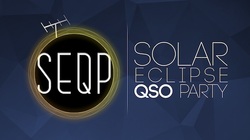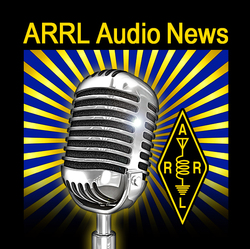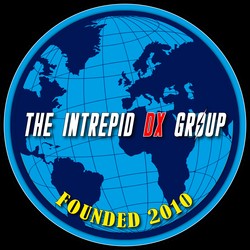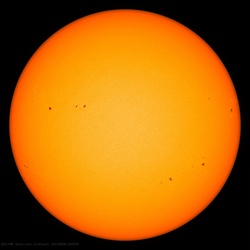 September 28, 2023 John E. Ross, KD8IDJ, Editor
| ||||||
Solar Eclipse QSO Party Seeks Amateurs and Radio Enthusiasts for Global Experiment ARRL is proud to partner with HamSCI to help promote participation in the Solar Eclipse QSO Party (SEQP). SEQPs are a series of global experiments -- and you can be a part of them. Solar eclipses will pass across the continental United States on October 14, 2023, and April 8, 2024. All radio amateurs need to do is operate using any mode and any band for all or part of the day, then upload their logs. Participation can be from anywhere; you don't need to be near the path of the eclipse to contribute valuable data. You don't even have to be a licensed ham to participate in the experiment (only to transmit).
Or just get on the air and help provide data to better understand the ionosphere. The first SEQP is on Saturday, October 14, 2023, from 1200 - 2200 UTC, and participants may use any band or mode (except WARC bands). Researchers will take the submitted logs and work to derive meaningful observations from the data. ARRL members can find out more about the SEQP by reading "The Solar Eclipse QSO Party: A Fun Way to Support Radio Science" in the September/October 2023 issue of On the Air magazine. The On the Air podcast will feature the article's author, Gary Mikitin, AF8A, talking about the event. The episode will go live on October 12. Students Wanted: Talk to an Astronaut via Amateur Radio in 2024! There's an opportunity for STEM education via amateur radio that will put students in contact with astronauts. The Amateur Radio on the International Space Station (ARISS) program is seeking formal and informal education institutions and organizations, individually or working together, to host an amateur radio contact with a crew member aboard the International Space To maximize these radio contact opportunities, ARISS is looking for organizations that will draw large numbers of participants and integrate the contact into a well-developed education plan. The voice-only radio contacts are approximately 10 minutes long and allow students to interact with the astronauts through a question-and-answer session. Students also have an opportunity to learn about satellite communication, wireless technology, and radio science. The deadline to submit a proposal is November 10, 2023. Proposal information and more details, such as expectations, proposal guidelines, and the proposal form, can be found at www.ariss.org. An ARISS proposal webinar session will be held on October 5, 2023, at 7 PM ET. Visit https://ariss-proposal-webinar-fall-2023.eventbrite.com sign up. ARISS is a cooperative venture of international amateur radio societies and the space agencies that support the ISS. In the US, participating organizations include NASA's Space Communications and Navigation program (SCaN), the ISS National Laboratory -- Space Station Explorers, ARRL, and AMSAT. Additional information is available at ARISS.org. AMI Jamboree Scheduled for November The 2023 Amplitude Modulation International (AMI) Jamboree will be held over the Thanksgiving weekend, starting at dusk on November 24 and ending at dawn on November 27. AMI Executive Director John C. McGrath, N9AMI, said the jamboree is not a contest but rather an AM-only operating event. "Everyone is The preferred AM bands for operation are:
According to the club's history, AMI was formed in 1993. The name was taken from a west coast amateur radio club that was no longer in operation. AMI is now dedicated to the enjoyment, promotion, and preservation of AM. Club memberhips include numbered membership certificates, an organization of 10 regions with directors, annual operating events, local club support, and the monitoring of activities that affect AM operations. While the FCC reduced the peak-envelope power measurement for AM, they also issued a statement in support of continuing the mode's important place in amateur radio. More information is available on the AMI website. Amateur Radio in the News ARRL Public Information Officers, Coordinators, and many other member-volunteers help keep amateur radio and ARRL in the news. "Meet the Gaston County man who is the oldest living ham radio operator in the U.S." / The Gaston Gazette (North Carolina) September 22, 2023 -- The Gaston County Amateur Radio Society is an ARRL Affiliated Club. "Ham radio event set for Sept. 30 in South Point" / The Hearld - Dispatch (Ohio) September 22, 2023 -- The Southern Ohio Amateur Radio Association is an ARRL Affiliated Club. "Amateur radio emergency test drill Sept. 30" / The Monroe News (Michigan) September 26, 2023 - The Monroe County Amateur Radio Public Service Corps. "Longmont Amateur Radio Club to celebrate Peak to Peak Byway anniversary" / Times - Call (Colorado) September 27, 2023 -- The Longmont Amateur Radio Club is an ARRL Affiliated Club. "Volunteer Amateur Radio Operators restore vital communication link in Waushara County" / Waushara Argus (Wisconsin) September 27, 2023 -- Waushara County Amateur Radio Emergency Service®. Share any amateur radio media hits you spot with us. ARRL Podcasts On the Air The cover story of On the Air's September/October 2023 issue, "Foxhunting Basics," doesn't have anything to do with chasing down a woodland creature. Foxhunting is a radio direction-finding activity that you can enjoy with a radio club or group, or even with just one other friend -- and they don't even have to be a ham! Rob Zielfelder, N1NUG, explains how to get started with a couple of handheld radios and a directional antenna that you can make from inexpensive hardware store materials. One player hides somewhere with a radio, and sends intermittent transmissions, while the other player tracks them with the help of the radio's signal meter and a map. Listen to this month's episode for more information on how to join the fun. ARRL Audio News The On the Air podcast is available on iTunes (iOS) and Stitcher (Android). The On the Air podcast and ARRL Audio News are also on blubrry -- On the Air | ARRL Audio News. Announcements The Intrepid-DX Group has announced their 4th Annual Youth Dream Rig Essay Contest. The Intrepid-DX Group is a US-based nonprofit organization that promotes amateur radio activities around the world. The Youth Dream Rig Essay Contest is designed to gather the views and ideas of young people involved in amateur radio. On Wednesday, October 4, 2023, the Federal Communications Commission (FCC) and the Federal Emergency Management Agency (FEMA) will jointly conduct a nationwide test of the Integrated Public Alert and Warning System (IPAWS). The test is being conducted to make sure that the Emergency Alert System (EAS) and Wireless Emergency Alerts (WEAs) are working properly. The test will begin at approximately 2:20 PM ET and will be split into two sections. The first alert will test the WEAs, and the second will test the EAS. Your cell-network based mobile devices will alert at that time. Save the date for the upcoming Jamboree On The Air (JOTA) October 20 - 23, 2023. Jamboree-on-the-Air provides the opportunity for millions of Scouts around the world to meet on the air via Amateur Radio. In Brief... The ARRL Simulated Emergency Test (SET) is scheduled for October 7 - 8, 2023. The SET is ARRL's annual national emergency exercise designed to assess the skills and preparedness of Amateur Radio Emergency Service® (ARES®) volunteers, as well as those affiliated with other organizations involved in emergency and disaster responses. The SET is open to all radio amateurs and partner organizations, in addition to national, state, and local officials. To get involved, contact your local ARRL Emergency Coordinator or Net Manager. SET guidelines and report forms can be found at: ARRL Simulated Emergency Test (SET) Guidelines+. The K7RA Solar Update Tad Cook, K7RA, of Seattle, Washington, reports for this week's ARRL Propagation Bulletin, ARLP039: Solar activity was up this week, September 21 - 27, 2023. Eight new sunspot groups appeared: two on September 21, two on September 22, two on September 25, one on September 26, and one on September 27.
The average daily sunspot number jumped from 118.4 to 170.6, while the average daily solar flux increased from 149.3 to 168.8. The autumnal equinox was last weekend in the Northern Hemisphere, so Earth is bathed in equal amounts of solar radiation in both hemispheres. The average daily planetary A index decreased from 20.4 to 17, while middle latitude numbers changed from 18.1 to 13.7. Thursday had the strongest geomagnetic activity, and Alaska's college A index was 68, triggering a geomagnetic storm with aurora visible across the northern tier of the United States. Activity peaked around 1200 - 1800 UTC, with the planetary K index at 5.33. Regarding solar flux predictions, the next predicted peak is at 168 on October 20 - 23. Predicted solar flux values are 160 and 158 on September 28 - 29; 155 on September 30 through October 1; 152 on October 2 - 3; 155 on October 4 - 6; 160 on October 7 - 8; 155 on October 9; 150 on October 10 - 11; 145 on October 12 - 14; 150, 155, 155, 160, and 165 on October 15 - 19; 168 on October 20 - 23; and 164, 160, 160, 168, and 150 on October 24 - 28. Predicted planetary A index is 8 on September 28 - 29; 12 on September 30 through October 1; 8, 5, and 8 on October 2 - 4; 5 on October 5 - 21; 10 and 8 on October 22 - 23, and 5 on October 24 - 31. Weekly commentary on the sun, the magnetosphere, and the Earth's ionosphere on September 27, 2023, from OK1HH: "During September, we saw nearly regular fluctuations in solar and geomagnetic activity. M-class flares occurred nearly every day, some accompanied by plasma eruptions [of] coronal mass ejections (CMEs). On [September] 24 - 25, the fourth and strongest solar-origin proton cloud (G3) of the month struck Earth. With such a large number of disturbances, each lasting several days, there was a significant decrease in [maximum usable frequency] (MUF) and a general deterioration of shortwave propagation (September 3 - 5, 13 - 15, 18 - 20, and since [September] 25). After these disturbances, due to the high solar activity, relatively rapid improvements followed, the best of which was observed from [September] 10 onward. It culminated in a positive phase of disturbance during the daytime hours of UTC on [September] 12, with the highest MUF values, and thus the best opening of the upper shortwave bands. This also made the following deterioration, which started already on the night of [September] 13, even more noticeable. Given the number and duration of disturbances and despite several improvements, overall propagation was below average. This pattern began in August, and given the trend in solar activity, looks set to continue for the time being." Gregory Andracke, W2BEE, sent over these two articles about aurora borealis: https://nbcnews.to/3PUVH9q and https://bbc.in/3PQLhrj. Check out his website, at Sunspot numbers for September 21 - 27, 2023, were 159, 184, 198, 172, 164, 179, and 138, with a mean of 170.6. The 10.7-centimeter flux was 168.1, 175.7, 173, 173.7, 170.2, 164.9, and 156, with a mean of 168.8. Estimated planetary A indices were 10, 8, 10, 21, 23, 32, and 15, with a mean of 17. The middle latitude A index was 10, 7, 9, 17, 15, 26, and 12, with a mean of 13.7. A comprehensive K7RA Solar Update is posted Fridays on the ARRL website. For more information concerning radio propagation, visit the ARRL Technical Information Service, read "What the Numbers Mean," and check out the Propagation Page of Carl Luetzelschwab, K9LA. A propagation bulletin archive is available. For customizable propagation charts, visit the VOACAP Online for Ham Radio website. Share your reports and observations. A weekly, full report is posted on ARRL News. Just Ahead in Radiosport Yearlong -- ARRL Volunteers On the Air (VOTA). See the State Activations Schedule for weekly W1AW Portable Operations, including:
Upcoming Contests:
Visit the ARRL Contest Calendar for more events and information. Upcoming Section, State, and Division Conventions
Search the ARRL Hamfest and Convention Database to find events in your area. Have News for ARRL? Submissions for the ARRL Letter and ARRL News can be sent to news@arrl.org. -- John E. Ross, KD8IDJ, ARRL News Editor
ARRL -- Your One-Stop Resource for
Subscribe to...
Free of charge to ARRL members...
| ||||||
 During these celestial events, you can join thousands of fellow amateurs as part of the largest crowd-sourced event for ham radio scientific exploration. The SEQP is part of the Festivals of Eclipse Ionospheric Science and is for learning more about how the ionosphere works.
During these celestial events, you can join thousands of fellow amateurs as part of the largest crowd-sourced event for ham radio scientific exploration. The SEQP is part of the Festivals of Eclipse Ionospheric Science and is for learning more about how the ionosphere works. Station (ISS). ARISS anticipates that the contacts will be held between July 1 and December 31, 2024. Crew scheduling and ISS orbits will determine the exact contact dates.
Station (ISS). ARISS anticipates that the contacts will be held between July 1 and December 31, 2024. Crew scheduling and ISS orbits will determine the exact contact dates.-2023-logo.jpg) welcome to participate, and there is a certificate available for those who contact 25 stations and submit a log," said McGrath. "Each class winner will receive a certificate, and a short biography will be posted on the AMI website. While the age of the equipment doesn't matter, there must be an AM mode selection on the radio," he added.
welcome to participate, and there is a certificate available for those who contact 25 stations and submit a log," said McGrath. "Each class winner will receive a certificate, and a short biography will be posted on the AMI website. While the age of the equipment doesn't matter, there must be an AM mode selection on the radio," he added..jpg)
 Listen to
Listen to  Contestants must be USA or Canadian amateur radio license holders who are 19 years old or younger; must reside in the US, US territories, or Canada, and they must submit a two-page essay explaining what attracted them to amateur radio. All entries must be a plain text document, PDF, or Microsoft Word document and be either emailed to
Contestants must be USA or Canadian amateur radio license holders who are 19 years old or younger; must reside in the US, US territories, or Canada, and they must submit a two-page essay explaining what attracted them to amateur radio. All entries must be a plain text document, PDF, or Microsoft Word document and be either emailed to 
-2023-small.jpg)
-Blue.jpg)








